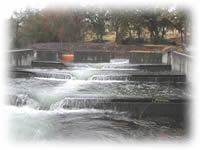| COOPERATIVE CONSERVATION CASE STUDY | | Fisheries Restoration and Irrigation Mitigation Act Program | | Voluntary fish passage and screening partnership for Fish, Farms and Communities | | Location: Midwest/Northern High Plains | | Project Summary: This voluntary, citizen-based, cost shared program helps protect fish without impairing water withdrawals from streams for farming, ranching, hydropower and municipal purposes. |
|  | | FWS |
|
Resource Challenge For decades state, tribal, and federal fishery agencies in the
Pacific Northwest have identified the screening of irrigation and other water diversions, and improved fish passage, as being of critical importance in protecting, recovering, sustaining, and avoiding endangered species listings of anadromous and resident fish populations. It is estimated that over 80% of water diversions are unscreened. Conservation districts, counties, cities and towns, irrigation districts, Native American tribes, resource conservation and development councils, and conservation organizations have long sought assitance to address these concerns so that fish can be protected while meeting farming, ranching, hydropower and municipal needs. | Examples of Key Partners The program administered by the U.S. Fish and Wildlife Service, is a collaborative voluntary partnership of state, tribal, federal, and local governments in Idaho, Montana, Oregon, and
Washington. Collaboration on program direction is aided by an advisory committee made up of state, tribal, and federal representatives (FRIMA Steering Committee). |
| Results and Accomplishments 85 projects have been funded in FY 2002-2004. These projects protect 656 stream miles and have fixed 15 fish barriers and installed 68 fish screens. In addition, 9 inventories were conducted, 1 database was developed, and 5 pre-design analyses were conducted. Over 150 cooperators have been involved. Strong partnerships led to the high cost sharing amount of 58% of total funding. |
|
Innovation/Highlight This voluntary, citizen-based, cost shared program helps protect fish and meet farming, ranching, hydropower and municipal needs. |
| |
 Land Conservation
Land Conservation Conservation
Conservation Arkansas
Arkansas California
California Colorado
Colorado Houston
Houston Idaho
Idaho Louisiana
Louisiana Maine
Maine Mississippi
Mississippi Habitat
Habitat
 Land Conservation
Land Conservation Conservation
Conservation Arkansas
Arkansas California
California Colorado
Colorado Houston
Houston Idaho
Idaho Louisiana
Louisiana Maine
Maine Mississippi
Mississippi Habitat
Habitat